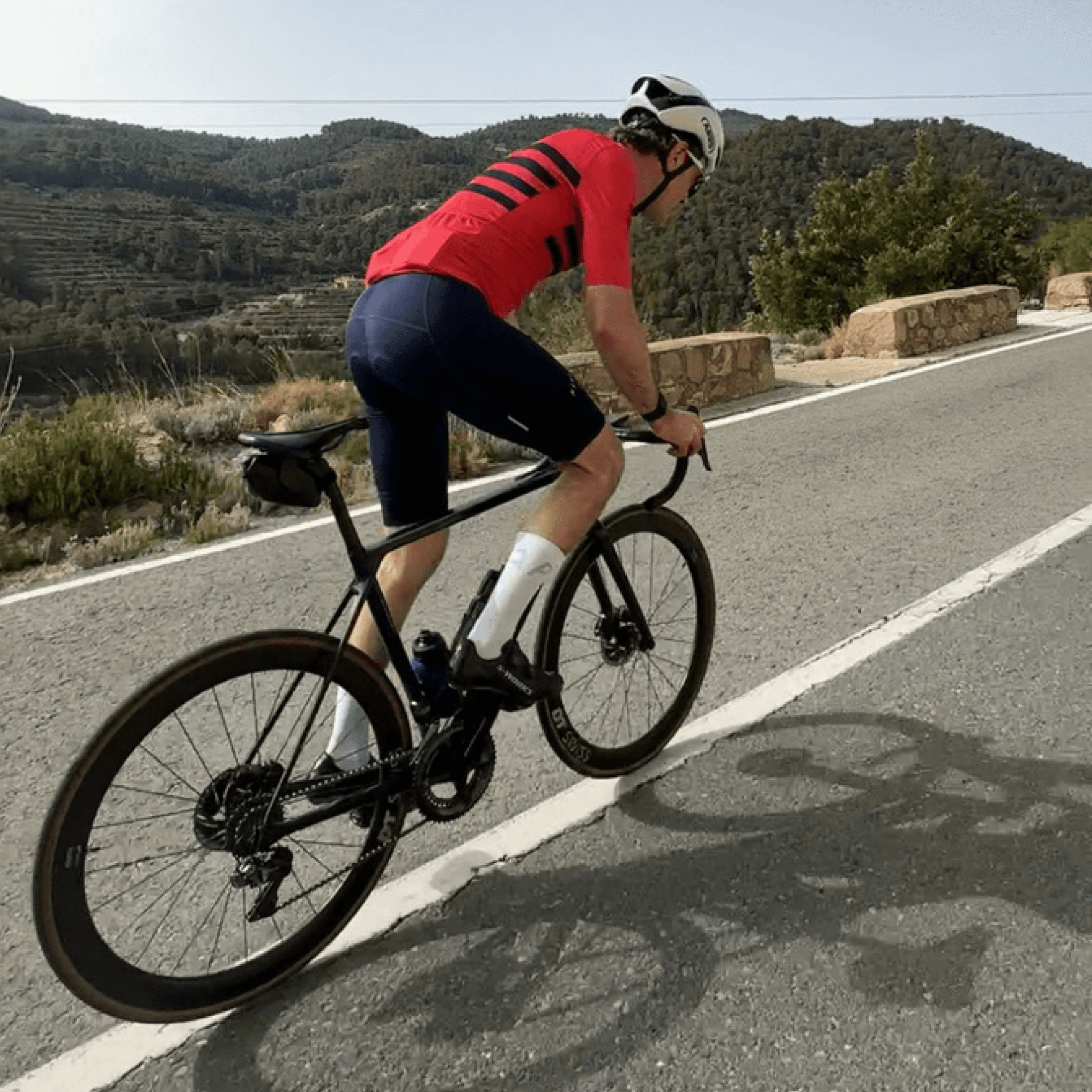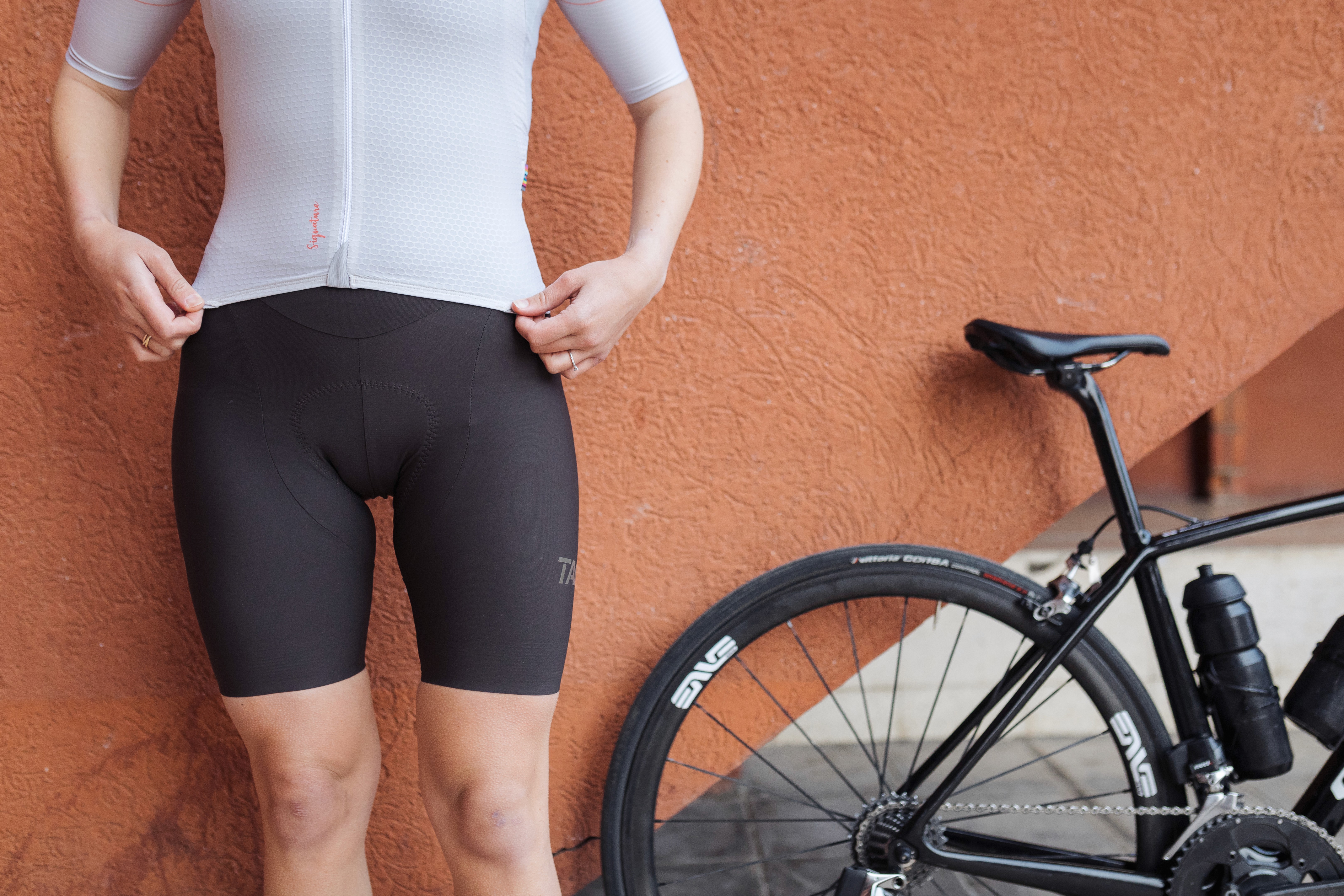Core Stability Exercises For Cyclists

Sep 6, 2022

Core Stability Exercises For Cyclists
Sep 6, 2022

Core Stability Exercises For Cyclists

Sep 6, 2022

With an example of a core stability training scheme
You can't fire a cannon from a canoe. This is the best way to describe why core stability is so important for a cyclist. In this article we briefly explain why every cyclist should include core stability training in his daily routine and what exercises are the most useful.
Why cycling core workouts are important
Core stability are all the muscles of the back, abdomen, buttocks and hip that provide a stable posture. These muscles are used daily to a greater or lesser extent. On the bike you need them to effectively transfer the power of your legs to the pedals. A better trained core ensures that the posture remains stable during the pedaling movement so that all the power is transferred to the pedal stroke as effectively as possible. Especially at high pedaling frequencies, a better trained core ensures that you do not bounce off the saddle and at very low pedaling frequencies (and a high torque), for example when toiling uphill, it ensures that all power flows to the pedal. You will notice that you need these muscles if you cycle uphill a lot and your lower back starts to ache. The same can happen during long stretches against the wind. If your goal is to climb a mountain, it makes sense to give these muscles extra attention when training off the bike.
With an example of a core stability training scheme
You can't fire a cannon from a canoe. This is the best way to describe why core stability is so important for a cyclist. In this article we briefly explain why every cyclist should include core stability training in his daily routine and what exercises are the most useful.
Why cycling core workouts are important
Core stability are all the muscles of the back, abdomen, buttocks and hip that provide a stable posture. These muscles are used daily to a greater or lesser extent. On the bike you need them to effectively transfer the power of your legs to the pedals. A better trained core ensures that the posture remains stable during the pedaling movement so that all the power is transferred to the pedal stroke as effectively as possible. Especially at high pedaling frequencies, a better trained core ensures that you do not bounce off the saddle and at very low pedaling frequencies (and a high torque), for example when toiling uphill, it ensures that all power flows to the pedal. You will notice that you need these muscles if you cycle uphill a lot and your lower back starts to ache. The same can happen during long stretches against the wind. If your goal is to climb a mountain, it makes sense to give these muscles extra attention when training off the bike.
With an example of a core stability training scheme
You can't fire a cannon from a canoe. This is the best way to describe why core stability is so important for a cyclist. In this article we briefly explain why every cyclist should include core stability training in his daily routine and what exercises are the most useful.
Why cycling core workouts are important
Core stability are all the muscles of the back, abdomen, buttocks and hip that provide a stable posture. These muscles are used daily to a greater or lesser extent. On the bike you need them to effectively transfer the power of your legs to the pedals. A better trained core ensures that the posture remains stable during the pedaling movement so that all the power is transferred to the pedal stroke as effectively as possible. Especially at high pedaling frequencies, a better trained core ensures that you do not bounce off the saddle and at very low pedaling frequencies (and a high torque), for example when toiling uphill, it ensures that all power flows to the pedal. You will notice that you need these muscles if you cycle uphill a lot and your lower back starts to ache. The same can happen during long stretches against the wind. If your goal is to climb a mountain, it makes sense to give these muscles extra attention when training off the bike.

JOIN takes your cycling to the next level
Looking for a smarter way to train? JOIN creates customized cycling plans based on your goals and progress, making sure you're always on track.

JOIN takes your cycling to the next level
Looking for a smarter way to train? JOIN creates customized cycling plans based on your goals and progress, making sure you're always on track.

JOIN takes your cycling to the next level
Looking for a smarter way to train? JOIN creates customized cycling plans based on your goals and progress, making sure you're always on track.
5 rules for a good core workout for cyclists
The fact that most cyclists are not used to core stability training often lies in the lack of knowledge of what exactly they can do. In addition, many routines are quite too long and you'd rather spend that time on the bike. Therefore below please find our 5 rules for a good core stability routine.
Work on your core stability at least 3 times a week. Less is too little while more is better.
Do the same exercises as much as possible. Keep it simple, this way you ensure that you actually do it. Bring in some new exercises only after 8 weeks when you feel the need for a new set.
Always do it at the same time. For example, right out of bed or after you get out of the shower, before bed. It doesn't really matter, but work on that routine.
A total set of exercises including rest, should not last more than 5 to 8 minutes. Longer is not necessary and only makes it harder to stick to the routine.
Train back, abdomen, buttocks and hip in equal measure. Be especially careful not to overwork those abs because you want to have that hot beach body. If the balance is missing, it can actually lead to additional pain in your back or elsewhere.
Our top-5 core exercises for cyclists
With the above tips in mind, here are 5 exercises suitable to any cyclist. Ideally, you should do all the exercises for 40 seconds. If that is not possible, start with 20 seconds and slowly build up to 40 seconds. If it is too easy for you, do the exercises for a maximum of 60 seconds. Between the exercises you keep 5 seconds rest. A yoga mat is nice but not really necessary, a carpet works fine as well.
The superman plank.
Put both your hands and knees on the floor, then simultaneously extend your left arm and right leg and hold this position with slight movements for 40 seconds. Then it's the turn of the right arm and left leg.
The bicycle crunch
It sounds more complicated than it is and there are countless versions, but while cycling in the air you raise your upper body about 10 centimeters off the ground. In doing so, you can try to use your hands under your head to touch your knee with your elbows, but this is not a must. As long as you start to feel the abdominal muscles you're OK. This also trains your hips through the cycling movement.
The side plank
Lie on one elbow and hold your body in the air like a plank. The oblique abdominal muscles in particular will get a good workout. You can make this exercise extra heavy by moving your upper leg 10 to 20 centimeters up and down, or by dipping the hips to the floor.
The bridge with leg raises
Lie on your back, then lift your buttocks off the ground and bring your knees to a 90-degree angle. Tighten the buttocks and abdomen so that your knees, hips, and shoulders are in a straight line. Then alternate extending the left and right leg all the way out.
Knee-to-elbow plank
Bring yourself in the plank position but with arms extended and hands on the floor. Keep the rest of the body stretched. Then alternately move the left knee to the right elbow and vice versa.
If this routine is still too difficult, make the duration of the exercises a little shorter. If you notice that you need more rest between the exercises, then also shorten the duration of the exercises, so that the total set does not take too long. Finally, do not forget to breathe. This may sound obvious but sometimes it is forgotten in the heat of the moment.
5 rules for a good core workout for cyclists
The fact that most cyclists are not used to core stability training often lies in the lack of knowledge of what exactly they can do. In addition, many routines are quite too long and you'd rather spend that time on the bike. Therefore below please find our 5 rules for a good core stability routine.
Work on your core stability at least 3 times a week. Less is too little while more is better.
Do the same exercises as much as possible. Keep it simple, this way you ensure that you actually do it. Bring in some new exercises only after 8 weeks when you feel the need for a new set.
Always do it at the same time. For example, right out of bed or after you get out of the shower, before bed. It doesn't really matter, but work on that routine.
A total set of exercises including rest, should not last more than 5 to 8 minutes. Longer is not necessary and only makes it harder to stick to the routine.
Train back, abdomen, buttocks and hip in equal measure. Be especially careful not to overwork those abs because you want to have that hot beach body. If the balance is missing, it can actually lead to additional pain in your back or elsewhere.
Our top-5 core exercises for cyclists
With the above tips in mind, here are 5 exercises suitable to any cyclist. Ideally, you should do all the exercises for 40 seconds. If that is not possible, start with 20 seconds and slowly build up to 40 seconds. If it is too easy for you, do the exercises for a maximum of 60 seconds. Between the exercises you keep 5 seconds rest. A yoga mat is nice but not really necessary, a carpet works fine as well.
The superman plank.
Put both your hands and knees on the floor, then simultaneously extend your left arm and right leg and hold this position with slight movements for 40 seconds. Then it's the turn of the right arm and left leg.
The bicycle crunch
It sounds more complicated than it is and there are countless versions, but while cycling in the air you raise your upper body about 10 centimeters off the ground. In doing so, you can try to use your hands under your head to touch your knee with your elbows, but this is not a must. As long as you start to feel the abdominal muscles you're OK. This also trains your hips through the cycling movement.
The side plank
Lie on one elbow and hold your body in the air like a plank. The oblique abdominal muscles in particular will get a good workout. You can make this exercise extra heavy by moving your upper leg 10 to 20 centimeters up and down, or by dipping the hips to the floor.
The bridge with leg raises
Lie on your back, then lift your buttocks off the ground and bring your knees to a 90-degree angle. Tighten the buttocks and abdomen so that your knees, hips, and shoulders are in a straight line. Then alternate extending the left and right leg all the way out.
Knee-to-elbow plank
Bring yourself in the plank position but with arms extended and hands on the floor. Keep the rest of the body stretched. Then alternately move the left knee to the right elbow and vice versa.
If this routine is still too difficult, make the duration of the exercises a little shorter. If you notice that you need more rest between the exercises, then also shorten the duration of the exercises, so that the total set does not take too long. Finally, do not forget to breathe. This may sound obvious but sometimes it is forgotten in the heat of the moment.
5 rules for a good core workout for cyclists
The fact that most cyclists are not used to core stability training often lies in the lack of knowledge of what exactly they can do. In addition, many routines are quite too long and you'd rather spend that time on the bike. Therefore below please find our 5 rules for a good core stability routine.
Work on your core stability at least 3 times a week. Less is too little while more is better.
Do the same exercises as much as possible. Keep it simple, this way you ensure that you actually do it. Bring in some new exercises only after 8 weeks when you feel the need for a new set.
Always do it at the same time. For example, right out of bed or after you get out of the shower, before bed. It doesn't really matter, but work on that routine.
A total set of exercises including rest, should not last more than 5 to 8 minutes. Longer is not necessary and only makes it harder to stick to the routine.
Train back, abdomen, buttocks and hip in equal measure. Be especially careful not to overwork those abs because you want to have that hot beach body. If the balance is missing, it can actually lead to additional pain in your back or elsewhere.
Our top-5 core exercises for cyclists
With the above tips in mind, here are 5 exercises suitable to any cyclist. Ideally, you should do all the exercises for 40 seconds. If that is not possible, start with 20 seconds and slowly build up to 40 seconds. If it is too easy for you, do the exercises for a maximum of 60 seconds. Between the exercises you keep 5 seconds rest. A yoga mat is nice but not really necessary, a carpet works fine as well.
The superman plank.
Put both your hands and knees on the floor, then simultaneously extend your left arm and right leg and hold this position with slight movements for 40 seconds. Then it's the turn of the right arm and left leg.
The bicycle crunch
It sounds more complicated than it is and there are countless versions, but while cycling in the air you raise your upper body about 10 centimeters off the ground. In doing so, you can try to use your hands under your head to touch your knee with your elbows, but this is not a must. As long as you start to feel the abdominal muscles you're OK. This also trains your hips through the cycling movement.
The side plank
Lie on one elbow and hold your body in the air like a plank. The oblique abdominal muscles in particular will get a good workout. You can make this exercise extra heavy by moving your upper leg 10 to 20 centimeters up and down, or by dipping the hips to the floor.
The bridge with leg raises
Lie on your back, then lift your buttocks off the ground and bring your knees to a 90-degree angle. Tighten the buttocks and abdomen so that your knees, hips, and shoulders are in a straight line. Then alternate extending the left and right leg all the way out.
Knee-to-elbow plank
Bring yourself in the plank position but with arms extended and hands on the floor. Keep the rest of the body stretched. Then alternately move the left knee to the right elbow and vice versa.
If this routine is still too difficult, make the duration of the exercises a little shorter. If you notice that you need more rest between the exercises, then also shorten the duration of the exercises, so that the total set does not take too long. Finally, do not forget to breathe. This may sound obvious but sometimes it is forgotten in the heat of the moment.
More Relevant Articles
Discover valuable training tips to enhance your cycling performance.
More Relevant Articles
Discover valuable training tips to enhance your cycling performance.
More Relevant Articles
Discover valuable training tips to enhance your cycling performance.

Unlock Your Cycling Potential Today
Join thousands of cyclists who have improved their performance with JOIN's training plans.

Unlock Your Cycling Potential Today
Join thousands of cyclists who have improved their performance with JOIN's training plans.
By joining, you agree to our Terms and Conditions and our Privacy Policy.

Unlock Your Cycling Potential Today
Join thousands of cyclists who have improved their performance with JOIN's training plans.
By joining, you agree to our Terms and Conditions and our Privacy Policy.



